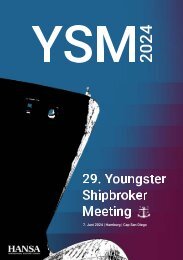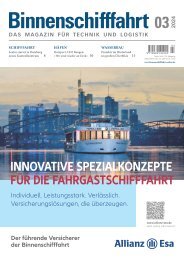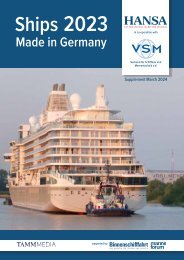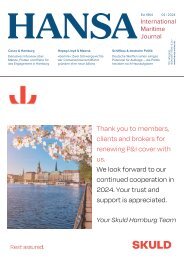HANSA VSM Special - Ships made in Germany 2022
Die englischsprachige Sonderpublikation „Ships made in Germany“ erscheint in offizieller Kooperation mit dem Verband für Schiffbau- und Meerestechnik (VSM). Die Publikation dient der internationalen Darstellung der deutschen Werftindustrie! Es werden herausragende Neubauprojekte sowie der aktuelle Auftragsbestand auf deutschen Werften beschrieben. Die Redaktion der HANSA kürt das „Ship of the Year“.
Die englischsprachige Sonderpublikation „Ships made in Germany“ erscheint in offizieller Kooperation mit dem Verband für Schiffbau- und Meerestechnik (VSM). Die Publikation dient der internationalen Darstellung der deutschen Werftindustrie! Es werden herausragende Neubauprojekte sowie der aktuelle Auftragsbestand auf deutschen Werften beschrieben. Die Redaktion der HANSA kürt das „Ship of the Year“.
You also want an ePaper? Increase the reach of your titles
YUMPU automatically turns print PDFs into web optimized ePapers that Google loves.
INLAND SHIPS MADE IN GERMANY<br />
The zero-emission<br />
push boat »Elektra« <strong>in</strong><br />
its home port of Berl<strong>in</strong><br />
© BEHALA<br />
First of its k<strong>in</strong>d<br />
»Elektra« is the world’s first zero-emission push boat. The vessel features a battery<br />
electric propulsion system comb<strong>in</strong>ed with hydrogen and fuel cells, this unique<br />
newbuild<strong>in</strong>g can serve as a bluepr<strong>in</strong>t for a variety of barges and coastal vessels<br />
This newbuild<strong>in</strong>g is proof of German shipbuild<strong>in</strong>g capabilities.<br />
The »Elektra« was built over 2.5 years at<br />
the shipyard Hermann Barthel and features batteryelectric<br />
propulsion system comb<strong>in</strong>ed with hydrogen and<br />
fuel cell technology, reportedly the world’s first for a<br />
push boat.<br />
The basis of the newly developed hybrid system is the<br />
battery package, consist<strong>in</strong>g of 242 DNV-approved GO<br />
1050 modules with a total capacity of 2.5 MWh, delivered<br />
by EST-Floattech, and three maritime fuel cell systems<br />
(NT-PEMFC, 100 kW peak power each). Although<br />
the battery and fuel cells will be used together to power<br />
the electric motors for complete redundancy, the two<br />
powertra<strong>in</strong>s are <strong>in</strong>dependent systems. On hydrogen, it<br />
can travel a m<strong>in</strong>imum of 100 km over a 16-hour day or<br />
longer. The 20-m-long pusher with a beam of 8.2 m and<br />
a draft of 1.25 m will deliver an electric power capacity of<br />
21,200 kWh for a round trip from Berl<strong>in</strong> to Hamburg.<br />
Christened by godmother Franziska Giffey, the Mayor<br />
of Berl<strong>in</strong>, <strong>in</strong> April <strong>2022</strong>, the »Elektra« is the product of a<br />
partnership between eight dedicated firms. Under the<br />
project management of the Department of Maritime Systems<br />
Design and Operations at the Technical University<br />
of Berl<strong>in</strong>, BEHALA – Berl<strong>in</strong>er Hafen- und Lagerhausgesellschaft<br />
(logistics), shipyard Hermann Barthel,<br />
Ballard Power Systems (fuel cells), Argo-Anleg (hydrogen<br />
system), SER Schiffselektronik Rostock (electrical energy<br />
system), EST-Floattech (battery system) and HGK Ship-<br />
58 <strong>HANSA</strong> – International Maritime Journal


















